In Slovakia there are many firms, that sell and install tile fireplaces, stoves and kitcheners. However, some of them publicize advantageousness of their products only because they can not build any other type. Sellers of fireplace inlays sometimes argue that by overlaying the fireplace with the tiles, a radiant heat will be created, but they misguide the customers with it. By hot air fireplaces with any overlaying fast circulation takes place and the proportion of radiation is only very small. For the building of the heat storage stoves an experienced tile stove mason is definitely needed. The heat of the tiled heat storage stove is of the highest quality and most comfortable at the same time. In the countries of Western Europe these stoves are very popular because of quality of the heat and because of low operational demandingness. Professional tile stove masonry firm must be chosen very thoroughly. You will thus prevent unnecessary problems. Today at the final house approval and next to revision report for the chimney also a certificate of expertise from the tile stove masonry firm is being required. As a guarantee of expertise can serve for sure a membership in one of the Slovak guilds of the tile stove masons. In order to be able to correctly choose a heating body corresponding to your demands, we indicate a survey of the basic concepts, which will help you in this matter, pros end cons of individual types of heating as well as comparison of the situation in various countries of Europe.
This is a fireplace without inlay and with open brickwork fire space. Similar were being built in the past. They were owned by castle dwellers in mansions and castles but also in houses. Fireplace without inlay has year-long tradition, but serves more for aesthetical purposes. It does not provide much heat, it warms only persons sitting relatively near, and only as long as they feed the fire. To its disadvantages belongs also the fact, that it has the highest fuel consumption of all heating bodies mentioned. In spite of the fact, that the classical fireplaces look simple, they are harder to build as the types with inlays, and many firms are not even able to manage this. These types of fireplaces usually require a chimney of greater diameter, it depends on the size of the fire space and the room. Our firm builds around 2 to 5 of such classical fireplaces per year.
What about abroad?
Similar situation exists also in Poland. If a Slovak or a Pole decided, what he is going to have built, he would usually decide for hot air with inlay. In Austria, on the contrary, the customer surely decides to have classical fireplace without inlay. A common Austrian requires originality, and in this case he is not interested in the fact, that classical fireplace does not provide much heat and he chooses romanticism by the classical fireplace. Modern hot air classical fireplace, unfortunately, never can provide this.
In our country, in Slovakia, this is the „hit“ of the 90-ies. It is popular not only from the point of view of quality of heating, but only because of strong promotion and lower price. When compared with the classical and hypocaustic stoves it belongs to the cheaper heating media. On what principle does it heat?
Hot air fireplace consists of a cast iron or steel fireplace inlay, which is overlayed with bricks, fire-clay bricks or ceramic lining – the „tiles“. Other supplementary materials are used as well, such as marble, granite, stone, wooden mantelpieces, sandstone etc. Its heating capabilities exceed to greater extent those of the previous type, however it is comparatively cheaper and more simple to install. For the time being it is the easiest system from the point of view of building, which means a skilled worker is able to learn most quickly by building a hot air fireplace. Of course, strict fire fighting measures must always be observed. And even more so by the hot air fireplaces and hot air stoves!
What is important in this hot air installation is the quality of fireplace inlay, it decides, how much heat will the fireplace produce. Whether the fireplace inlay is overlayed by tiles or stones, has not such a great substantial influence neither to output, nor from the point of view of length of time of heat retention in the fireplace cladding or in the room itself. Circulation – fast exchange of air –originates by combustion of wood in a hot air fireplace. The fireplace heats up the air through hot metallic inlay. The air then flows upwards, to the ceiling of the room, and after cooling up it falls down to the floor. So streams of hot air are originated – hence the name of these fireplaces. Hot air types of firing spaces heat up the surrounding room relatively quickly, however, heat drop between ceiling and the floor is usually great. Their users often complain having hot and dry air in the space around their head, while having cold feet at the same time. Important is also higher fuel consumption and necessity to feed the fire more frequently as compared with the tile masonry stoves. Hot air fireplaces can be connected with a heat-conductive complement for the radiators, hot-water heater, floor heating etc.
Advantages:
Disadvantages:
What about abroad?
Hot air fireplaces are being built mostly in our country and in Poland, they gain on popularity also in Ukraine and the countries of Eastern Europe. In the Czech Republic they are not so widespread, and in Austria, Germany and other western countries they are built only minimally. According to our experience, in Austria only one in 20 customers (predominantly coming from Slovakia or countries of former Yugoslavia) builds hot air fireplace and around 95 % of the buildings are tile stoves.
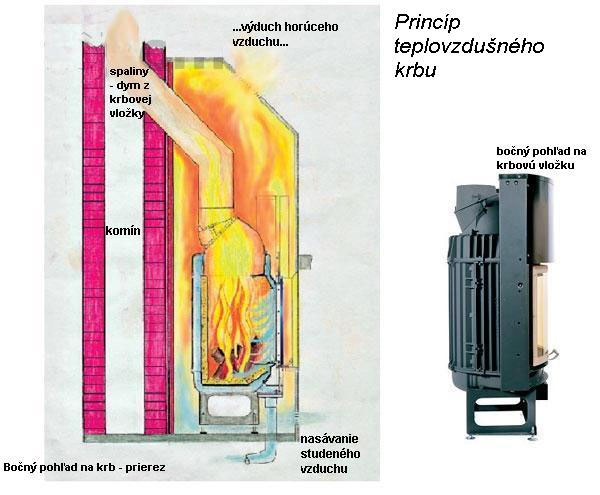
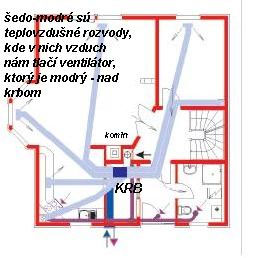
Mentioned equipment is considered by our organization to be the most saving and healthy heating. Interior of the radiant stove is made of bricks or fireclay-bricks, which spread the heat through radiation. Heat radiation creates relatively low temperature in the interior, but no increased air flows are originated, heat drops are small and humidity of the environment fluctuates around the optimal value 30 – 50%. So it cerates agreeable and healthy heat comfort. Radiant stoves are heating the room in which they are placed, by means of additional draughts – vents or „Zugs“ (every tile stove mason can give them also different names), which can lead though also into other rooms. You can thus with one stove heat the whole residential object. To the contrary of the hot air types, in heat storage bodies is the heat transfer mediated through waste products from combustion. Thanks to the closed circuit of draughts the fuel consumption in them is minimal, and it is enough to feed the fire approximately twice a day. This applies first of all to the stove without grate; in the time of closing the doors there is no more supply of fresh air to the fire space and after burning of the wood the bottom fireclay brick, which serves in place of a grate, is hot. When dry wood chips are added to the extinguished fire space even the next day, they catch fire without problem, so that it is not necessary to make a fire in the stove again. But one has to learn how to fire in the stove, there is a certain procedure to it. The surface of radiating, as well as grateless stoves, is finished by tiles or plastering tiles. From the point of view appearance we distinguish among whole-tile stoves, white or combined with tiles and plaster. Such equipment can be built only by the professional tile stove mason.
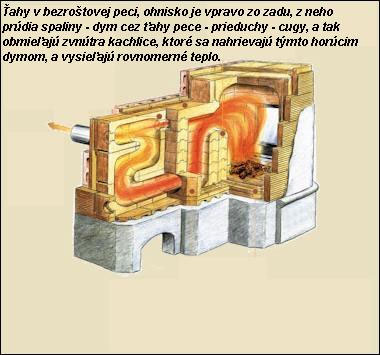
The equipment of the tile stove with the grate produces heat on the similar principle, the only difference being that the grate is placed inside the fire space and the ashes can be taken up in this case in an ash-tray. Feeding the fire in this stove is only a little more frequent that in the case of the grateless one, we still range this stove to the most effective and most qualitative equipments. The mentioned stove serves mainly for heating in the same room, where it is actually built. This equipment can be built only by the professional – tile stove mason. By the building of the stove strict fire fighting measures must be observed by the worker.
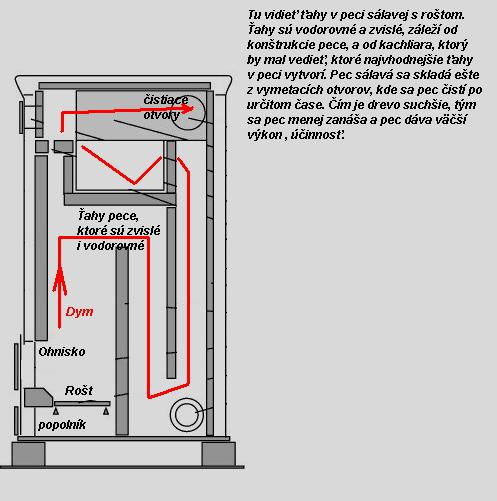
Advantages of radiant stoves with the grate and also without the grate:
Disadvantages of the radiant stoves with grate as well as without the grate:
What about abroad?
These stoves are built most of all in Austria, Germany and other western countries. They are maximally popular there because of the quality of heat. In our country they were built in the past in the form of tall room tile stoves, but later they were often demolished. They were also being built in the Czech Republic, Poland, Hungary in the Ukraine it is therefore probably the type of tile stove that proved itself to be the most successful! In the western countries there is today similar type of the stoves, the only difference being they advanced chiefly in the field of design. Besides tall standing stoves also other different shapes are being built there, sometimes rugged and lower. In our country the outer appearance was concentrated sometimes to 2-3 styles of design.
Combined devices provide more types of heating, and namely radiant as well as hot air. It can be said with some simplification, that this stove is divided inside to the half. First part, where there is the fire space – it is hot air type, the fumes from it do not go directly to the chimney, but they pass through the other part of the stove by means of draughts – vents – “Zugs”. Consumption of fuel in the combined bodies is higher in comparison with the radiant stove, but on the other hand lower as in the hot air or open fireplace. But their advantage consist also in the fact, that from the hot air part distribution can be conducted even up to the more remote rooms. The stove does not retain the heat after having stopped heating so thoroughly, as an original radiant stove does, its output depend on construction, quality of the fireplace inlay and on the good workmanship of the tile stove mason. Practical solution is to let the quality radiant heat be in the room, where the stove is situated and to direct hot air discharge outlets to other rooms, where the demand for heat quality is not so high, for instance in the attic, corridor, bathroom and the like. This device can be built only by the tile stove mason – professional, and strict fire fighting measures must be observed.
Combined stoves were built rather rarely in our country in the past and they were a little different technically, because at that time the fireplace inlays did not exist. The tile stove mason would build the fire space and he placed an air gap behind it. In this gap then flowed the heated air for example to the corridor, or to the room upstairs. This air did not have very strong heat output, but it was more agreeable as the strongly heated air from the fireplace inlays. Such systems were in use not only in our country, but also in Austria, where we have made reconstructions on them in the recent time.
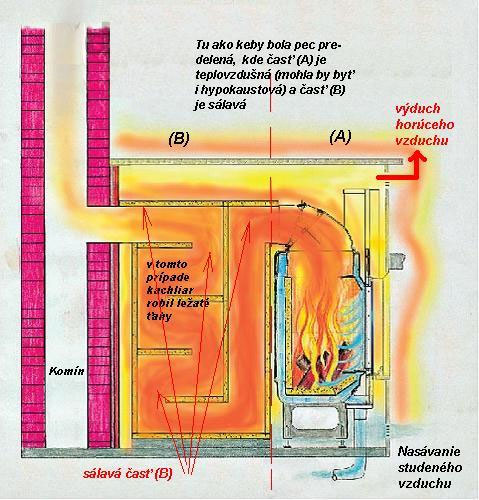
Advantages of the tile stove with combined radiant and hot air, or hypocaustic heating:
Disadvantages of the tile stove combined with radiant hot air or hypocaustic heating
Hot air tile stove operates on similar principle as the hot air fireplace does, but with the difference consisting in the fact, that it resembles a radiant tile stove with its appearance. Inner part of the stove is hollow, as in the hot air fireplace however the inlay in this tile stove is taller and narrower. It produces heat of lesser quality, so it is on the same or similar principle as the hot air fireplace is. This device can be built also by any skilled professional – fire place builder, he must only master connection – composition of the tiles, and strict fire fighting measures must be observed during the building process.
This type of stoves is a pride of the companies, which are not able to produce stoves on the principle of radiant heat. They maintain, they are building tile stoves, but attention, these stoves are not originally radiant as the tile stove is, practically it is only a hot air heating only overlayed with tiles.
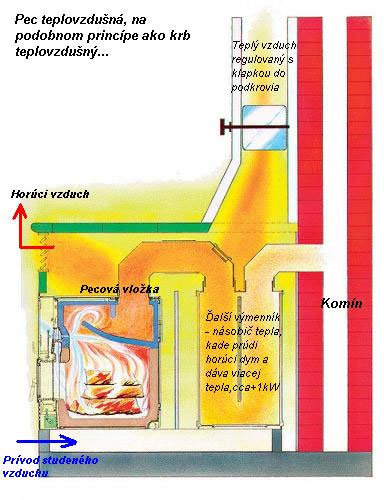
Advantages:
Disadvantages:
This device takes advantage of the principle of hot air in the closed space. Contrary to the hot air bodies, where the hot air circulates permanently in the rooms, by the hypocaustic stove there are no openings to outlet this hot air. So the hot air, which originates from the steel or cast iron inlay or from other fire space within the hypocaustic stove, circulates and rubs the inner walls made up from tiles or from other appropriate material thus heating them up. To the advantages of this stove belong variety of shapes, ruggedness and original demanding appearance. If it reaches also into other rooms, the heated air from the stove inlay reaches to all parts of the stove, thus heating also all rooms up. Firms that are dealing with hypocaustic heating suggest that the heat produced is of such a quality as is the heat from the radiant stove, but there is a substantial difference between them. Radiant stove is namely heated through the flow of fumes – combustion products, which circulate in the draughts, it heats the tiles up and has optimal fuel consumption. Hypocaustic stove is heated through flow of hot air it means the fire space is separated from the tiles by an air gap. Consumption of the fuel in it depends on the type of stove inlay and on the draught system. When comparing the hypocaustic and radiant stove from the point of view of experience, we consider only the radiant stove to be still of the highest quality, whether considering health aspects of the heating or according to the fuel savings.
This device can be built also by a skilled professional – fireplace builder, he only has to master the process of connecting -composing the tiles. It is necessary to observe strict fire fighting measures during building of the stove.
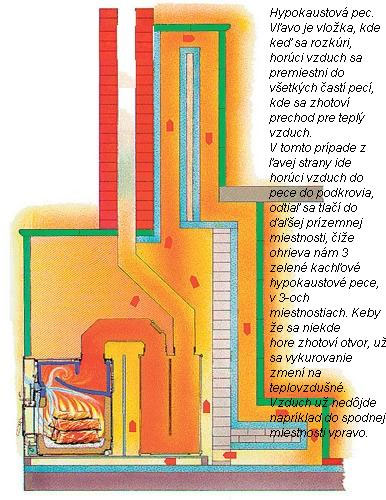
Advantages:
Disadvantages:
A kitchen stove – kitchener – serves mainly for cooking and baking, but it can prove itself to be a good helper also by heating. If the kitchener has 2 fire spaces, it is possible to connect it with so called horseshoe for radiators. When the fire is on in the lower fire space, kitchener as well as radiators are in operation, when there is fire in the upper fire space, only kitchner is used. The horse shoe can be connected also to the portable kitcheners, which is more price advantageous. The built-in kitchener can have an output of approx. 10 kW to 13 kW. A kitchener is placed mainly into kitchen, but it can be used also in multi-purpose rooms, for example in weekend-houses or cottages.
A kitchener is considered to be more or less radiant heat, but it must be fed more. It heats up the room quickly from the hot plates and a well built kitchener retains heat after feeding it with wood from evening till next morning. It can not, though, retain heat as long as the radiant stove does.
Here is the overall scheme of fuel consumption comparison by the individual types of heating.
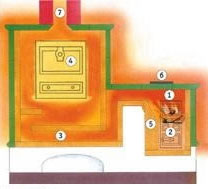
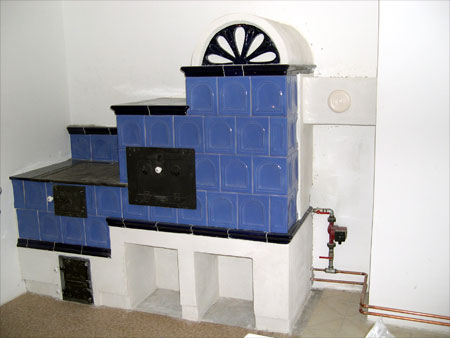
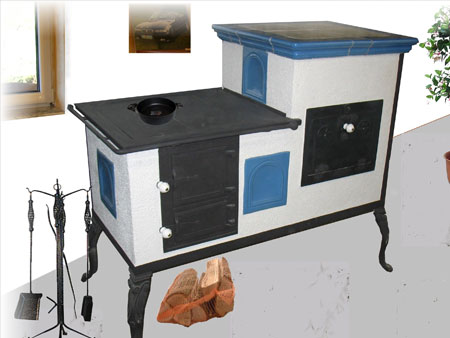
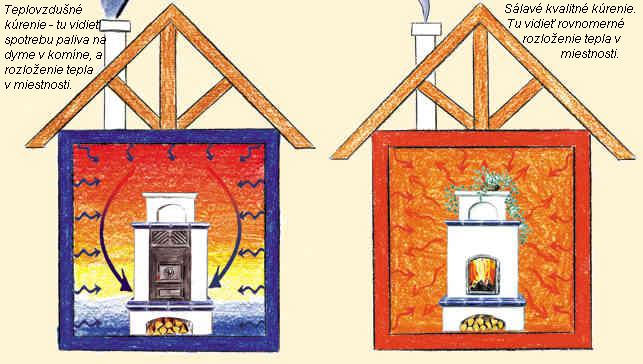
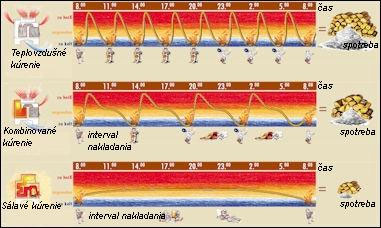
We describe here quite frequently, that the mentioned device can be built by a skilled professional – fireplace builder or on the contrary, by a professional tile stove mason. Even though in Slovakia there is an approved handicraft activity „tile stove mason“ or „tile stove masonry“, we know, that after finishing apprenticeship period in this handicraft, the person concerned should be able to master all buildings. In truth, and we know it, it is not so in reality. Many of these firms concentrate only on the building of fireplaces, and they are not able to build masonry tile stoves, or they do not want to concentrate themselves to the building of the masonry tile stoves because of building demandingness, and that is why we mention it here, because we know what kind of professional worker is needed for what type of stove.